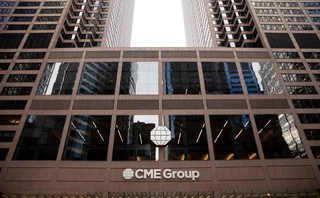

Review of 2019: shaken, not stirred
The market survived a cocktail of hits. But is a hangover on the way?
Ructions in the repo market. An inverted yield curve. Banks hiding risky exposures. Investment funds halting redemptions. The warning signs of a crisis were everywhere in 2019. And yet the financial system emerged largely unscathed. Global stocks surged, bond yields tightened. Bank earnings beat expectations.
That is not to say everything is rose-tinted. The convulsions in the repo market are troubling. Some blame post-crisis regulations, which force banks to hold more cash and make it harder for them to step into markets when they wobble. In the US, those rules are being recalibrated. The Volcker Rule has been simplified, and capital and liquidity requirements were eased for smaller banks. Further changes to the leverage ratio and stress tests are in the pipeline.
Meanwhile, the industry faces the mammoth task of moving $350 trillion of derivatives, loans and bonds to new benchmarks ahead of Libor’s expected death in 2021.
Here, we look back at some of the year’s biggest Risk.net stories, and those with greatest potential to shape the coming 12 months.
A REPO MYSTERY

On September 17, the cost of overnight funding in the repo market shot up to 10% – more than four times the usual rate. The melt-up was initially blamed on the benign coincidence of Treasury settlements and quarterly corporate tax payments falling due on the same day. But as Risk.net reported in November, other structural shifts added to the stress: most notably, a steady decline in excess reserves at banks and the popularity of the Fixed Income Clearing Corporation’s sponsored repo programme, which some say concentrated business at a handful of banks and tilted the market towards overnight funding.
A review published by the Bank for International Settlements in December confirmed much of Risk.net’s reporting.
Since September, the Fed has injected more than $200 billion into the market to keep rates in check. More will be needed to stave off another rate spike at year-end, when banks tend to step out of the market ahead of regulatory deadlines, causing liquidity to dry up.
But the underlying structural problems remain. Finding a fix will not be easy. The Fed could expand its balance sheet again. Post-crisis liquidity rules could be relaxed to encourage more lending. Or the Fed could establish a standing repo facility – an idea first discussed by members of its policy-setting committee in January 2018 – to exert direct control over the repo rate, effectively elevating it to a monetary policy standard in the eyes of the market.
“It was an extraordinary day and very unusual” – James Slater, Bank of New York Mellon (Repo rate hits 7.25% on year-end volatility, January 2)
“What is notable now is – because of the Federal government’s financing needs – the large amount of US Treasury coupon supply that is hitting the market on a regular basis” – Susan Hill, Federated Investors (SOFR tipped to hit 300bp at quarter-end, March 28)
“Repo itself has a bit of an image problem – people just don’t understand the market and what would cause such a move [at year-end]” – Christian Rasmussen, UBS (Fed repo facility may fix SOFR’s image problem, April 2)
“The theme of levered counterparties buying a bond, funding overnight versus term, allowed for a substantial – and arguably too much – overnight funding on leveraged positions” – head of the financing desk at a primary dealer (All clear? Structural shifts add to repo madness, November 5)
“If three or four G-Sibs have to dramatically reduce their footprint [at year-end], then that could be a significant amount of money leaving the market-place and effectively a reserve drain, because they’d be unwilling to convert reserves into Treasury repo if repo spiked” – EG Fisher, Mariner Investment Group (Squeezed or saved? Market divided over year-end repo stress, December 16)
SOFR, SUSPECT

The spasms in the repo market cast a long shadow over the Fed’s chosen replacement for US dollar Libor – the secured overnight financing rate (SOFR) – which is pegged to repo rates.
But in an ironic twist, a bit of volatility may have been just what was needed to boost the anaemic market for derivatives referencing the new benchmark.
At the start of the year, dealers worried the relative illiquidity of SOFR-linked derivatives would dissuade clients from moving to the new benchmark ahead of Libor’s death. Only 52 SOFR swaps changed hands in 2018, with a traded notional of $6.3 billion. But as the first quarter drew to a close, a $6 billion SOFR swap hit the market, followed by a $3 trillion trade. Both were live only from March 29 to April 1 and appeared to be a hedge against a quarter-end repo spike. The idea quickly caught on. The following week saw 27 SOFR swaps traded with July 3 expiries, covering the end of the second quarter. On September 17, trading in CME SOFR futures hit record levels.
The big catalyst for SOFR swap adoption will arrive in 2020 when clearing houses begin using the new benchmark as the discount rate for US dollar swaps – a move some are calling the biggest single transformation in the swaps market in three decades. Clearing houses spent the first half of 2019 nailing down a compensation mechanism for neutralising any value transfers. CME initially planned to make the switch in July but has since aligned its timetable with LCH, setting up a ‘big bang’ in October 2020.
“We need more issuance in SOFR and those issuances will need to extend out beyond two years in maturity, which is the longest maturity that we’ve seen [in SOFR debt]” – Thomas Pluta, JP Morgan (SOFR, so bad: liquidity lags transition ambitions, February 4)
“Some people are going to want to bet on the repo market, and there’s certainly an opportunity for them to get involved” – a rates trader at an asset management firm (Jumbo SOFR swaps herald new world of repo betting, March 22)
“We have received significant support for the one-time switch of discounting and PAI in a manner that is co-ordinated across CCPs and perhaps including the bilateral market as well” – Agha Mirza, CME (LCH plans October 2020 SOFR discounting switch, August 1)
FALLBACK FUN AND GAMES

While the market for swaps linked to new risk-free rates (RFRs) was starting to show signs of life, responsibility for moving legacy contracts off Libor fell to the International Swaps and Derivatives Association. It was a delicate task, with traders second-guessing the fallback methodology and regulators interjecting with new demands.
Isda is developing a fallback protocol that will transition legacy contracts to a term-adjusted version of overnight rates plus a fixed spread representing the difference with Libor. Traders picked over Isda’s consultations for clues about how that historical spread – which effectively dictates the basis between Libor and a given RFR after time is called on the ill-fated benchmark – would be calculated.
When the preliminary results of a consultation seeking feedback on three different methodologies was published in November 2018, the market response was immediate – the sterling basis moved 12%. By September, Isda had whittled it down to two options – a median measurement over five years, or a trimmed mean over 10 years. When the final decision was made in late November – with the five-year median winning out – the basis narrowed again, this time by 13% at the 30-year part of the curve.
While all this was going on, regulators threw Isda a curve ball. In March, the co-chairs of the Financial Stability Board’s Official Sector Steering Group called on Isda to add a fallback trigger that would automatically switch legacy swaps to new RFRs if Libor is deemed to be non-representative. Isda’s initial consultation on the matter was inconclusive. Regulators kept up the pressure and the consultation was re-opened in December.
Isda plans to finalise its fallback protocol in the first half of 2020, regardless of the outcome of the second consultation on pre-cessation triggers.
“Market participants could find themselves forced either to continue using Libor in legacy contracts within a severely disrupted market or agree bilaterally on terms at which they could close out across a wide array of contracts and counterparties, which would likely be difficult” – Andrew Bailey, UK Financial Conduct Authority, and John Williams, New York Fed, in a March 12 letter to Isda (FSB says fallbacks should kick in if Libor no longer accurate, April 3)
“If it’s a five-year lookback, I have a sheet that can calculate the basis right now, and all I have to guess is what the end date of Libor is” – a rates trader at a US bank (Ahead of the curve: how traders profited from Libor fallbacks, June 19)
“There are some big unknowns out there and we still lack key details on pre-cessation and exactly how this fallback is triggered” – Phil Lloyd, NatWest Markets (Sonia-Libor basis narrows after fallback verdict, November 20)
“If a strong majority of market participants supports a ‘non-representativeness’ pre-cessation fallback trigger for Libor derivatives in response to this consultation, then we would work to implement pre-cessation fallbacks” – Scott O’Malia and Katherine Tew Darras, Isda, in a December 4 letter to Andrew Bailey and John Williams (Isda to poll Libor users on pre-cessation triggers, again, December 4)
ROLLING BACK THE FEARS

In 2018, US regulators issued a raft of rule changes aimed at lightening banks’ capital and compliance load.
Three of the proposals – a new framework for regulatory ‘tailoring’ based on risk factors, changes to the Volcker rule, and the standardised approach to counterparty credit risk (SA-CCR) – were adopted in 2019.
The tailoring rule, finalised in October, frees mid-sized banks – those with a few hundred billion dollars in assets – from the Fed’s enhanced capital and liquidity rules. After it was proposed, BB&T agreed to buy SunTrust in the largest bank merger since the financial crisis. The combined entity, Truist, is now the sixth largest bank is the US, with more than $425 billion in assets.
Some other proposals had wrinkles that needed to be ironed out. The Volcker rule revisions introduced an accounting test that banks said would inadvertently broaden the number of trades captured. Others worried about the netting treatment of daily-settled swaps under the SA-CCR proposal. Those concerns were addressed in the final rules, which were adopted in October.
The stress capital buffer proposal and planned changes to the enhanced supplementary leverage ratio are still on the docket to be finalised in 2020.
“Contrary to reports and expectations, the G-Sibs have not seen significant changes in regulatory requirements under the Trump administration” – Gabe Rosenberg, Davis Polk (For US banks, billions in regulatory manna, January 9)
“If the accounting prong goes through as proposed, it will wipe away all the regulatory benefits” – Hugh Conroy, Cleary Gottlieb Steen & Hamilton (Regulators rethink Volcker overhaul to solve accounting glitch, January 14)
“The technical distinction that the SA-CCR proposal makes is not supported by law. Not allowing offset because of some purported concern that it may not be possible legally to do that, when it is possible legally to do it, is not rational” – Michael Voisin, Linklaters (US version of SA-CCR could hurt settled-to-market swaps, March 29)
“More of the mid-size banks, with greater risk for each of these banks, does not seem safer to me. How could it?” – Darrell Duffie, Stanford (US mid-sized banks may bulk up. (Is that safe?), May 23)
THE SHOCKING TRUTH

In May, Risk.net received an anonymous email from a concerned reader. “BANKS ARE CHEATING ON THEIR STRESS TESTS !!!” the sender declared, in all caps. Attached was a memo detailing a US bank’s offer to temporarily swap assets with a European bank over the turn of the year. The memo notes the trade would help the US bank with “liquidity needs during stress testing periods” and that the favour would be repaid during the European stress testing period.
In interviews, several sources confirmed that it was not unusual for banks to enter into such trades around stress tests, though some were surprised to see it discussed so openly.
Regulators are aware of the problem. To deter window-dressing, the Fed uses a floating start date, which can fall anywhere between October 1 and March 1, for the global market shock portion of its annual stress tests. European regulators want to do the same. In June, the European Banking Authority proposed moving to a floating start date as part of a wider overhaul of its stress tests. But after a backlash from banks, that proposal was set aside, at least until 2022.
“All the banks we had a discussion with shared the same concern. It is the top issue. For some banks, it is just impossible if it is on any day – even if it is end-of-month, it would be very difficult” – Hannan Mohammad, KPMG (Floating start date for 2020 stress test alarms EU banks, September 24)
“Because banks know about the stress test and they know they need to apply the scenario with a cutoff date as of the end of the year, they may change the composition of their market risk portfolio” – Angel Monzon, European Banking Authority (How banks game stress tests: the ‘shocking’ truth, September 30)
“The views of stakeholders are very different, and there is some time needed for fact-finding and for putting together possible options or proposals” – Mario Quagliariello, European Banking Authority (Keeping watch: EBA stress-testing head plans overhaul, October 23)
THE END OF LAST LOOK?

In August, Risk.net published an analysis of last look practices in the foreign exchange market, finding patchy levels of disclosure among the top 50 liquidity providers. Nearly a quarter did not make their last look policies public, nor would they share them with Risk.net. More than half declined to publicly state the length of their last look and hold times, and a quarter refused to confirm whether they pre-hedge client trades during this window.
Disclosures were patchiest among non-bank liquidity providers – only three of the top six non-banks had public disclosures, versus all five of the top dealers.
Last look is the period of time after an order is received but before execution during which a liquidity provider conducts price and credit checks. The practice is controversial. Dealers say it protects them from ‘toxic’ flow and results in tighter spreads for clients. But critics warn it is open to abuse. Liquidity providers could use the delay to pre-hedge trades, impairing the price a client receives, or to reject orders that move against them.
The forex global code of conduct encourages liquidity providers to disclose their last look policies. But the code lacks effective policing, and trading venues are reluctant to get involved in that.
Some now favour a more drastic solution. After Risk.net published its report, six non-bank market-makers publically called for the practice of last look to be scrapped and replaced with firm pricing.
“Use of rejected order information is a huge concern. What valid reason could there be?” – Matt Clarke, XTX Markets (Forex ‘last look’: how non-banks stack up, August 1)
“Jump is unequivocally opposed to last look, and we think it should not be a part of forex market structure” – Mark Bruce, Jump Trading (Six big forex market-makers call for end to last look, August 7)
“If disclosures aren’t publicly available then it doesn’t really pass the smell test. If LPs have got something to be ashamed of in their disclosures then there’s an issue” – James Binny, State Street Global Advisors (How the top 50 dealers tackle forex last look, August 8)
CITI’S SCRAPE

When a hedge fund trading exotics options was blindsided by wild swings in the Turkish lira in 2018, it found itself so deeply in the red that it was unable to cover margin calls from Citi, its foreign exchange prime broker (FXPB). The failure left Citi with a $180 million loss and ignited a debate about the risks of staking clients in the forex market.
Some said Citi’s problems were of its own making. According to some of its rivals, the bank had underpriced its services and taken on clients whose creditworthiness was far from pristine, with some small clients allowed to be a hundred times levered on a single currency pair.
At Citi, heads rolled. Sanjay Madgavkar, who ran FXPB, was ousted and replaced with Chris Perkins, global head of over-the-counter clearing. In June, Risk.net broke the news that Citi has told some of its biggest high-frequency trading (HFT) clients – including HC Technologies, Jump Trading and Virtu Financial – to take their business elsewhere. The likes of BNP Paribas, Deutsche Bank and NatWest Markets jumped at the chance to take on some of those clients.
The episode prompted FXPBs to review their pricing and margins. Some hiked rates for riskier clients and others are upgrading their margin models. But some still see the potential for further mishaps, especially with the practice of over-allocating credit to HFT clients whose exposures are difficult to monitor in real-time. There are ways to mitigate this risk – with pre-trade credit checks and kill-switches, for instance – but these don’t work for all trades and have not been universally adopted in the market.
“Citi hasn’t been measuring the risk of client portfolios and counterparty credit well enough for a while. They outpriced the Street on a lot of more risky business that just didn’t make economic sense” – head of FXPB at a rival bank (Born again: Citi’s forex prime brokerage, May 9)
“This issue of over-allocation of credit could be a problem in the future, and it definitely relates to algos that could go wrong, but fat-finger errors are just as dangerous as out-of-control algos” – Peter Plester, Saxo Bank (A powder keg in forex: the prime broker business, June 4)
“I think having banks compete on credit is just not a sensible thing. But it just carries on and we’ve seen it repeat and repeat and repeat” – Marcus Butt, NatWest Markets (Forex prime brokerage fee jump unlikely, say dealers, June 18)
“We’ve had a couple of calls with Citi, which is one of the reasons we started putting redundancy into place a few months ago” – head of foreign exchange at a HFT firm (Citi culls HFTs from FXPB client list, June 19)
“We have been benefitting from the fallout. But firms that think they are going to move the business into me at the same rates… are delusional” – a source at a large FXPB (Rival FXPBs scoop up former Citi clients, July 8)
MARGIN FOR ERROR

In July, Risk.net broke the news that the fifth phase of the initial margin rules for non-cleared derivatives would not be going ahead as planned in September 2020.
The first four phases of the rules captured dealers and 20 or so large buy-side firms. But the so-called ‘big bang’ in 2020 would catch an estimated 641 buy-side firms – 10 times as many as the first four phases combined.
The industry called for a re-think, citing concerns about legal and operational bottlenecks. Those arguments ultimately won out. Regulators agreed to raise the compliance threshold for 2020 and give smaller firms an extra year to prepare, essentially turning the big bang into two smaller bangs.
But that means the final phase of the initial margin rules now coincides with the expected end of Libor’s use as a benchmark rate, which will also create a huge amount of legal and operational work. Some now worry that delaying the final phase of the initial margin rules will only lead to even bigger bottlenecks in 2021.
“The clarification is helpful in terms of addressing the expected bottleneck for September 1, 2020, but it’s not a panacea and we’re very hopeful that the regulators don’t stop here” – Tara Kruse, Isda (Dealers seek clarity on buy-side IM relief, March 21)
“I don’t think it will be scrapped, but deferring the $8 billion is a possibility I know some people are thinking about” – Patrick Pearson, European Commission (Initial margin ‘big bang’ could be deferred, says EC’s Pearson, May 14)
“We have heard from different market participants of the possibility of a delay of a year to the phase five implementation. It was raised at the end of last week and the expectation is that we will get an announcement any day now” – an associate at a law firm (Regulators plan to delay IM ‘big bang’ – market sources, July 16)
“The industry is still going to be staring at a pretty big mountain to climb for phase six from a capacity perspective, and that’s why no-one can take their eye off the ball, even though it’s been pushed out for a year” – Ed Corral, JP Morgan (Buy side continues with IM prep despite delays, August 21)
DIGGING DEEPER

It’s not often that quants are told to stop trying to model something. But that’s what Hans Buehler, a top quant at JP Morgan, suggested in a paper he co-authored in 2018 on ‘deep hedging’, a machine learning technique for hedging derivatives without the need for classical models, such as Black-Scholes.
When JP Morgan began using the new machine learning algorithms to hedge its vanilla index options flow books, it found them to be faster and more precise than existing models. The bank is rolling out similar approaches for hedging single stocks, baskets and light exotics.
Deep hedging has been hailed as a breakthrough in quantitative finance, heralding a shift away from classical modelling and towards more data-driven techniques. Several banks and technology vendors are testing similar approaches to hedging not only equities but also interest rate and commodity derivatives.
In a paper published in Risk.net in December, Kenjiro Oya, a quant at Nomura, showed how deep hedging can be applied to exotic interest rate derivatives, such as Bermudan swaptions.
At many banks, artificial intelligence has already moved from the research lab into the front office, where it is being used to optimise various aspects of trading.
Credit Suisse is using AI to forecast minute-to-minute price moves in foreign exchange markets. At Goldman Sachs, AI is used to model the market impact of stock trades. Meanwhile, UBS and Virtu are using it to decide where and when to place orders to achieve best execution.
“The real advantage is we are able to increase volumes quoted – because we are faster” – Hans Buehler, JP Morgan (JP Morgan turns to machine learning for options hedging, May 30)
“The future is working with data directly, with empirical distributions directly, rather than trying to invent a new parametric model every time and fit it to historical data” – Alexei Kondratyev, Standard Chartered (Deep hedging and the end of the Black-Scholes era, August 5)
“Broadly speaking, the models have improved trade execution by about 50% across all the trades that we’ve done in the last six months versus alternatives” – Michael Steliaros, Goldman Sachs (Goldman improves execution ‘by 50%’ with new algos, August 6)
“All we’ve done is coded everything a human trader would ever do” – Stephen Cavoli, Virtu Financial (How Virtu trained its intelligent algos, October 2)
“Really focusing on optimal routing can allow savings of easily 10% to 20% of the mid to trade cost” – Giuseppe Nuti, UBS (Machines can save 20% on routing orders, UBS says, October 10)
“This used to be a business where you’d just have a bunch of people in the room buying and selling currencies, and now it’s gotten to the point where AI is part of the solution” – John Estrada, Credit Suisse (Credit Suisse uses neural nets to call minute-ahead forex, November 19)
“I came up with this idea when I played around with the deep hedging paper”– Kenjiro Oya, Nomura (Hedging rate exotics, Bergomi-style, December 11)
WHY, ROBOT?

Risk.net also documented several cases of asset managers putting AI to disparate uses.
At Neuberger Berman, a machine learning model analyses credit card data to predict earnings surprises, which can jolt the firm’s options-selling strategies. Pimco is using machine learning to forecast prepayment risk in mortgage securities. AI models help Alliance Bernstein to identify the sliver of high-growth companies that are likely to succeed in the long-run.
Among the more unusual examples, PanAgora built a mandarin-reading algorithm to gauge the sentiment of Chinese retail investors on social media.
There are clear signs that AI will disrupt investing in meaningful ways. At least one firm – Dario Villani’s Duality Group – is leaving all investment decisions to its machines. But most firms are treading carefully. For instance, Lazard will only employ machine learning if it can identify a clear rationale for its outputs, while Acadian has erected ‘guardrails’ around the use of AI to avoid getting stung if its algorithms malfunction.
“The goal was to build a risk attribution system that could rival existing platforms by using machine learning methods” – Joseph Simonian, Natixis Global Investors (Natixis creates model to ‘learn’ how factors interact, February 21)
“While their non-linearity is an advantage in terms of modelling, the lack of transparency means that we don’t actually know what the learnt relationship is” – Yaz Romahi, JP Morgan Asset Management (Fund houses get picky over where to use machine learning, May 16)
“One of the motivations for choosing tree-based algorithms is that they tend to offer greater transparency” – Seth Weingram, Acadian Asset Management (Systematic manager puts up guardrails for AI, May 21)
“When you go into specific pools of loans, machine learning can capture nuances that we do not even take into account in the traditional models” – Stefano Risa, Pimco (Pimco deploys neural net model in agency bonds, August 8)
“The fact we had some real-time credit card data that we were able to analyse helped us avoid being short puts ahead of an earnings miss” – Ray Carroll, Neuberger Berman Breton Hill (Neuberger sidesteps option gap risk using AI and credit card data, September 19)
“Sell-side reports have numerical parts and then there is the whole subjective text where the analyst writes down what they feel about the company. Quantitative managers have completely ignored that part” – Kunal Ghosh, Allianz global Investors (Allianz Global Investors adopts NLP signals in equities, September 24)
Only users who have a paid subscription or are part of a corporate subscription are able to print or copy content.
To access these options, along with all other subscription benefits, please contact info@risk.net or view our subscription options here: http://subscriptions.risk.net/subscribe
You are currently unable to print this content. Please contact info@risk.net to find out more.
You are currently unable to copy this content. Please contact info@risk.net to find out more.
Copyright Infopro Digital Limited. All rights reserved.
As outlined in our terms and conditions, https://www.infopro-digital.com/terms-and-conditions/subscriptions/ (point 2.4), printing is limited to a single copy.
If you would like to purchase additional rights please email info@risk.net
Copyright Infopro Digital Limited. All rights reserved.
You may share this content using our article tools. As outlined in our terms and conditions, https://www.infopro-digital.com/terms-and-conditions/subscriptions/ (clause 2.4), an Authorised User may only make one copy of the materials for their own personal use. You must also comply with the restrictions in clause 2.5.
If you would like to purchase additional rights please email info@risk.net
More on Risk management
Bank ALM tech still dominated by manual workflows
Batch processing and Excel files still pervade, with only one in four lenders planning tech upgrades
Many banks ignore spectre of SVB in liquidity stress tests
In ALM Benchmarking exercise, majority of banks have no internal tests focusing on stress horizons of less than 30 days
Quant Finance Master’s Guide 2026
Risk.net’s guide to the world’s leading quant master’s programmes, with the top 25 schools ranked
ALM Benchmarking: explore the data
View interactive charts from Risk.net’s 46-bank study, covering ALM governance, balance-sheet strategy, stress-testing, technology and regulation
Staff, survival days, models – where banks split on ALM
Liquidity and rate risks are as old as banking; but the 46 banks in our benchmarking study have different ways to manage them
CME faces battle for clients after Treasuries clearing approval
Some members not ready to commit to 2026 start date; rival FICC enhances services
AI and the next era of Apac compliance
How Apac compliance leaders are preparing for the next era of AI-driven oversight
Responsible AI is about payoffs as much as principles
How one firm cut loan processing times and improved fraud detection without compromising on governance






